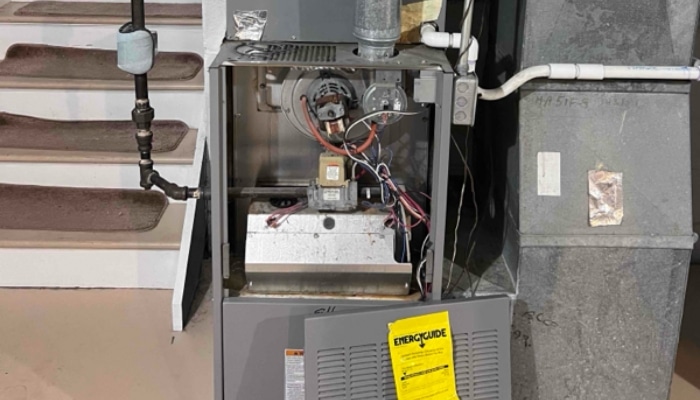
Do You Have an Furance Emergency or Common Repair Fix?
Furnaces are a privilege, but when they aren’t properly cared for they can quickly become a dangerous threat. Since furnaces utilize gas connections, electrical components, and fuel supplies, it makes them a more delicate asset to our homes. Proper maintenance and care are essential to minimize emergency issues. When you’re faced with a furnace repair issue, you need to be able to determine if it is an emergency repair or just a minor fix.
At Dustin’s Mechanical, your safety is our top priority, and we’re here to ensure that your furnace operates safely and smoothly throughout the heating season.
Contact us immediately if your furnace is showing symptoms of emergency furnace repair.
Furnace Safety
It’s crucial to emphasize the importance of furnace safety. A malfunctioning furnace can pose serious hazards, including a carbon monoxide leak, heater gas leak, or even a furnace fire in New Jersey. Regular maintenance and quick repairs can prevent these potentially life-threatening situations.
Minor DIY Preventative Maintenance Repairs
It’s essential to clarify which repairs fall under the category of preventative measures.
Some routine DIY maintenance tasks include:
- Replacing Air Filters: Furnace air filters maintain efficient airflow. Clogs from dust and debris force the furnace to work harder, potentially causing overheating, reduced efficiency, and system failures. Regular filter maintenance prevents emergencies.
- Check Thermostat Settings: The thermostat controls temperature by signaling the furnace to heat when it’s below your chosen setting. Proper thermostat adjustment enhances energy efficiency and lowers costs. Replace batteries for optimal functioning.
Most Common Reasons for Emergency Repair
Emergency furnace repairs can quickly turn a cozy home into a danger zone. Understanding the most common reasons for these urgent situations is crucial for homeowners.
The primary issues that can leave you in the cold at the most inconvenient times and possibly threaten your family’s safety include:
- Tripped Safety Switch: A tripped safety switch can result from various issues, such as overheating or a clogged filter which can cause increased carbon monoxide production or a fire hazard.
- Incomplete Combustion: Furnaces are built for efficient fuel combustion, but issues like malfunctioning burners or blocked vents can disrupt this process, leading to incomplete combustion and elevated CO levels inside your home.
- Furnace Exhaust Vent Blocked: A blocked exhaust vent can lead to carbon monoxide buildup in your home. This is a serious safety concern that requires immediate attention.
- Cracked Heat Exchanger: The heat exchanger in a furnace is responsible for transferring heat from the combustion process to the air that circulates through your home. Over time, heat exchangers can develop cracks or leaks. When this happens, combustion gases, including CO, can escape into the air that is blown into your home, increasing the risk of CO exposure.
- Overheating Furnace: An overheating furnace is characterized by internal components such as a heat exchanger or electrical wiring, reaching excessively high temperatures. This can pose risks such as a fire hazard.
How to Minimize Emergency Repairs
To minimize the need for emergency furnace repairs, consider these preventive heating service measures:
- Regular Maintenance: Schedule regular furnace maintenance with a qualified HVAC technician. They can inspect and clean the furnace, check for any signs of overheating, and ensure that all components are functioning correctly.
- Change Air Filters: Regularly replace or clean your furnace’s air filters to ensure proper airflow. Restricted airflow can lead to overheating.
- Proper Ventilation: Ensure that your furnace’s ventilation system, including the exhaust and intake vents, is clear of obstructions and functioning correctly to prevent overheating.
- Install Carbon Monoxide Detectors: Install carbon monoxide detectors in your home to provide early warning in case of a CO leak, which can be a result of an overheating furnace.
- Address Repairs Promptly: If you suspect your furnace is overheating or if it frequently shuts down, contact an HVAC professional immediately to diagnose and resolve the issue. Do not attempt to repair or troubleshoot the furnace yourself, as it can be dangerous.
Ensuring Safety with Dustin’s Mechanical
When it comes to furnace safety and emergency repairs, you can count on Dustin’s Mechanical. Our team of experienced technicians is trained to handle all types of furnace emergencies, from addressing ventilation problems to resolving gas valve issues. We offer 24/7 emergency services to keep your home warm and safe, even in the coldest of nights.
Emergency Furnace Repair Calls for Immediate Action
Don’t let a furnace emergency catch you off guard. By understanding the common reasons for emergency furnace repair and taking proactive steps to minimize the risk, you can ensure a warm and safe home during the colder months. Remember, when it comes to your furnace’s safety and reliability, Dustin’s Mechanical has got you covered. Trust us to keep your home cozy and secure all season long.
Contact us today for all your furnace repair and maintenance needs in central New Jersey!





